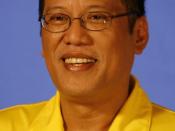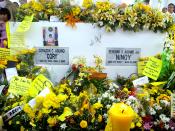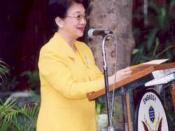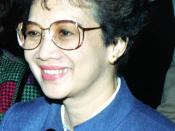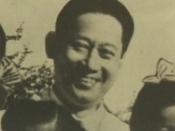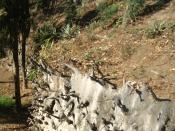Violeta Chamorro and Corazon Aquino Regina Benavides Leticia Ceballos Dr. Blommers Spanish 320 11-06-01 One could argue, behind each woman in power is a powerful man or an influential political dynasty. To spend a few minutes with either Violeta Chamorro or Corazon Aquino would make most people a firm believer of this.
Pedro Joaquin Chamorro Cardenal was the son of a newspaper publisher and a descendent of influential Nicaraguan statesman. Pedro could have never known that meeting a beautiful woman by the name of Violeta would forever engrave his name in history books. Growing up, Pedro frequently visited his father's newspaper plant and slowly began working. His many positions at La Prensa allowed him to appreciate the complexity of running a large company. After working as a writer, Pedro discovered his love for writing. Rather than watching his father's dreams dissolve, Pedro took over the position of "leader" after his death.
His new role allowed him to discover the power behind the written word. He began to use the La Prensa as a tool to voice decent against the Somoza dictatorship. Pedro's words were not only being read by Nicaraguan citizens, but by government officials as well. Pedro's blatant interpretation of government practices was the rationalization used for his many jail sentences. During 1957, repeated incarcerations caused Pedro and his family to be exiled to a distant town in northern Nicaragua. The Chamorro family escaped their predetermined fate by fleeing to Costa Rica where the lived for several years.
In 1960 in an amnesty, Pedro Chamorro returned to Nicaragua. He opposed the regime of Somoza's sons, Luis and Anastasio Somoza de Bayle, during the 1960s and 1970s, which again led him to be arrested and imprisoned.
Born on November 27, 1932, Benigno ''Ninoy'' S. Aquino, Jr. was destined to contribute significantly to his beloved nation's history. Ninoy looked up to the exemplary work of his grandfather, General Servillano Aquino, and his father, Senator Benigno Aquino, Sr. His father helped protect his countrymen from greater difficulties at a time when the country was most vulnerable, during World War II. Benigno was a popular critic of the Marcos dictatorship in the Philippines. Marcos imprisoned Benigno for his oppositional work and had agreed to free him if he left the Philippines. Benigno only agreed when he needed critical heart surgery, which needed to be performed in Boston. On October 11, 1954, Benigno marries Maria Corazon Cojuamgco at also of Tarlac, at the Our Lady of Sorrows Parish Church, Pasay. President Magsaysay serves as principal sponsor. Benigno decided to return to Manila to run for the presidential election of 1984.
Both men were unexpectedly and violently assassinated. This was the end to there revolution. Or, was it? Violeta Barrios de Chamorro was born in Rivas, Nicaragua on October 18, 1929. She was the daughter of a wealthy rancher and landowner. Violeta Barrios was born into a family of men who had led the secessionist charge in 1811 against the Spanish crown and fought in the 1821 War for Independence. She was educated in the United States at a Roman Catholic girls high school in San Antonio, Texas, and at Blackstone College in Southside, Virginia. She never completed her studies because she dropped out of college following the death of her father. In 1950, she married Pedro Joaquin Chamorro Cardinal, the son of a newspaper publisher and the descendant of influential Nicaraguan statesmen.
On January 10, 1978, Pedro Chamorro was assassinated while driving along a street in Managua. His death touched off a civil war in the country, and Violeta continued his attacks on the Somoza regime. She also contributed money to an anti-government insurrection known as the Sandanista National Liberation Front. When the Sandanistas defeated the Somoza regime in July 1979, they invited Violeta Chamorro to become one of the five-member, civilian executive junta in their government. She patriotically agreed, but grew disillusioned with the increasingly Marxist orientation of the new government, and after nearly a year, resigned. Before long, her newspaper was attacking the Sandanistas.
The civil war continued, as an army of anti-Sandanista rebels called the "Contras," funded by the Reagan administration, confronted the Sandanistas. The attacks on the government by "La Prensa" led to charges that the CIA backed it, and the paper closed down frequently by the Sandanistas. Chamorro fought the government for the right to publish without censorship, and in 1987, the Sandanista government backed down and allowed her to resume publication as an opposition newspaper.
In 1987, the presidents of Central American countries intervened to end Nicaragua's civil war. They agreed to disarm if the Contras if the Sandanistas would allow free elections. The Sandanistas agreed. A coalition of anti-Sandanista parties, the National Opposition Union (UNO), chose Violeta Chamorro as their candidate. She assailed the Sandanistas for betraying democratic principles, ruining the economy through excessive military spending, causing inflation, unemployment, and a large international debt. Chamorro defeated the Sandanista candidate Daniel Ortega. Her inauguration was on April 25, 1990.
Maria Corazon Cojuangco was born in Manila and was the sixth of eight children. Her family owned a sugar and rice empire so she grew up in a relatively wealthy family. She studied in the United States and graduated from the College of Mount St. Vincent in New York City in 1953. While her original intention was to study law, she gave up studying when she married Ninoy Aquino who became leader of the opposition to the then Marcos regime. She raised five children as well as providing support for her husband in his political career.
After the death of Ninoy, Corazon Aquino had hoped that the party would find someone else to run against Marcos, so that she would not have to be considered. She agreed to run if she had a million signatures on petitions requesting her to run, and so she did.
Marcos, thinking that he still had the people of the Philippines behind him, called for a snap election in 1986. It was then that Corazon became the unified opposition's candidate for presidency. She officially lost those elections to Marcos, but people believed that Marcos rigged the elections, and due to his mass corruption, he lost the support of the U.S. and the people. On February 25, 1986, both Aquino and Marcos were inaugurated as President by their respective supporters, leading to the "People's Revolution" and eventually the downfall of Marcos, making Corazon the 1st president of the Republic of the Philippines and also the first woman president of the Philippines.
These two women had many more similarities between them other than their sex. In their election campaigns, both Violeta and Corazon constantly reminded voters that they were carrying on the work of their deceased husbands. Both received the "Path to Peace Award". Both women claimed power not through proven political skills but on the strength and symbolism of their family ties. Although both were educated with at least some college they considered themselves to be house wives. They stayed home and raised their children and took care of their husbands. Both women made a strong mark in history by brining down two dictatorships that had been in power for decades. Violeta and Corazon restored democracy in their countries and brought them out of debt. Between the both of them they received many honorary degrees; such as awards for Woman of the Year, the Eleanor Roosevelt Human Rights Award, the United Nations Silver Medal, the Canadian International Prize for Freedom, and the International Leadership Living Legacy Award from the Women's International Center. She also appeared in Time magazine.
Although there are many simularities between these two women their were also few minor differences between them. Corazon graduated from college while Violeta left college after the death of her father. Both their husbands were assassinated for being out spoken in what they believed. Violeta knew when her husband died that she was going to take over his fight. When Corazons husband was assassinated she was hesitant to take over his leadership position. It took a powerful request from the citizens of the Philippines to persuade her to run for office.
As far as their impact on the lives of women both generally speaking and politically in the Philippines and Nicaragua, Violeta and Corazon accomplished a lot for women in terms of being the first woman presidents of their countries. Many of Corazons proclaimed policy priorities, addressing poverty, would have had positive impacts on women, for the majority of those impoverished are women. Also, two women ran after her for president. Although these women did not win, the fact that they even ran, illustrates that in some regards Corazon Aquino is partially responsible for "breaking the glass ceiling" in the Philippines. The same can be said for Violetta.
Ultimately, Corazon Aquino should be remembered for her unwavering commitment to democracy. While Violeta can be remembered as a reflection of what her country had gone through. For she had also experienced loss to political violence and her family was split along political lines. Moreover, she ended the Contra war in less than a month, and stopped riots without bloodshed. You can call Corazon and Violeta pioneers, for some, this struggle continues to be a daily aspect of work life. For others, their individual prominence and achievements now protect against incidents of gender-based inequality, while still others have benefited from the work of earlier generations of women who blazed the trails that they followed.
There was however no change in the social and economic circumstances under Aquino's government. It is important to realize that her government was pressured by huge popular expectations, as the people before her had been living under martial law for 14 years. She saw herself, as a transition president, from going to dictatorship to democracy, as she believed the Philippines would take at least 10 years to recover after Marcos Regime. It is also important to understand, that what could have influenced her ability to create change was the fact that she had to survive six coups and no one was loyal to her.
The change in Nicaragua's politics brought a cordial relationship Marxist-Leninist outpost in the Americas. During her term in office, she tried to reverse the politics of the Sandanistas, advocating a return to ownership of private property, a free market economy, no press censorship, and a de-emphasis on the military. She was called upon to display political skill in making appointments from among the wide range of political representatives in the polarized country. Chamorro stepped down at the end of her term as president. In the election of October 1996, Arnoldo Aleman defeated Daniel Ortega.
Aquino was portrayed in the media as just an ordinary housewife who was challenging a 20-year dictator for presidency, but this was never true. For she had been tutored in politics from an early age, was college educated, was part of a wealthy political family, and had a husband with political instinct and ambition. She came to power as a "clean-up mom," trying to move her country out of social and financial turmoil, and she wanted to keep her husband's political vision alive. She appeared as a shy, silent student and wife, but she was also seen as eventually growing into role as a leader.
Chamorro and Aquino were strong leaders of their countries. Although this was not a unanimous view, these women still deserve credit because they made it to a position that many strong and deserving women will never see BIBLIOGRAPHY 1. Cruz, Sonia de Baltodano and Guido HernÃÂández. Dreams of the Herat. New York: Simon &Schuster, 1996.
2. Komisar Lucy. Corazon Aquino: The Story of a Revolution. New York: George Braziller, 1987.
3. Genovese, Michael. Women as National Leaders. Newbury Park: Sage Publications, 1993.
4. .
5. Howard, G. Chua-Eoan. " All in the Family". Time Fall 1990: 33-34 6. Uglow, J. " Corazon Aquino." Ed. Macmiller. 1999. < http: www.//library.thinkquest.org/ 7. Coo1515/heroism>.
8. .
Related site: La Prensa (Spanish) Sources: Current Biography, 1990; Who's Who in the World, 1996
